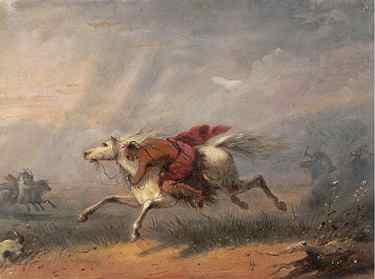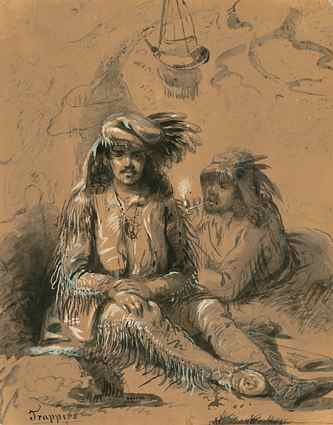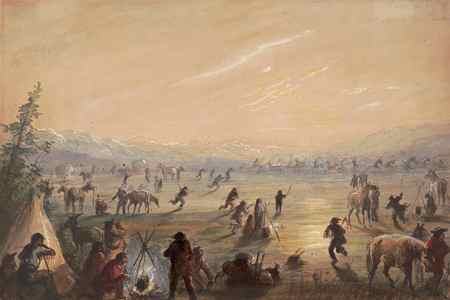Editor's note: The Nelson-Atkins Museum of Art
provided source material to Resource Library for the following article
or essay. If you have questions or comments regarding the source material,
please contact the Nelson-Atkins Museum of Art directly through either this
phone number or web address:
Romancing the West:
Alfred Jacob Miller in the Bank of America Collection
September 25, 2010 - January 9,
2011
Vibrant and masterful
mixed media works on paper by the artist Alfred Jacob Miller, depicting
the American West inspired by a six-month expedition in  1837, are on view in Romancing the West: Alfred Jacob
Miller in the Bank of America Collection, an exhibition that opened
this fall at The Nelson-Atkins Museum of Art in Kansas City, Mo., then travels
to the Museum of Fine Arts, Houston and to the Philadelphia Museum of Art
in 2011. (right: Alfred Jacob Miller (1810-1874), War Path,
Oil and glazes over graphite, ink and possibly watercolor on cream
wove paper, 9 x 12 1/4 inches. Bank of America Collection. Photo credit:
John Lamberton)
1837, are on view in Romancing the West: Alfred Jacob
Miller in the Bank of America Collection, an exhibition that opened
this fall at The Nelson-Atkins Museum of Art in Kansas City, Mo., then travels
to the Museum of Fine Arts, Houston and to the Philadelphia Museum of Art
in 2011. (right: Alfred Jacob Miller (1810-1874), War Path,
Oil and glazes over graphite, ink and possibly watercolor on cream
wove paper, 9 x 12 1/4 inches. Bank of America Collection. Photo credit:
John Lamberton)
Baltimore native Alfred Jacob Miller (1810-1874) was one
of the first American artists to paint the "Far West," considered
at the time as exotic and distant by people living in the East. Bank of
America's 30 sheets, which have not been on view to the public since 1964,
feature poetic images of the stunning landscape of early America, the daily
life of Native Americans and mountain men, and the exotic wildlife and fauna
he observed.
Miller traveled in 1837 with an American Fur Company expedition
at the invitation of Scotsman Capt. William Drummond Stewart. The group
left in April 1837 from St. Louis and followed what would become the Oregon
Trail, then traveled by way of the Green River to Wyoming's Wind River Mountains.
Miller made more than 100 field sketches during the expedition,
and his adventure became the inspiration for at least a thousand paintings
and watercolors. For nearly three decades, he received commissions for albums
of watercolors and full-sized oil paintings that he produced in his studio.
These works from the Bank of America Collection represent intermediary work
based on his field sketches and in preparation for works commissioned by
patrons. 
"We are thrilled to share Miller's work with
the general public," said Margaret C. Conrads, Samuel Sosland Senior
Curator, American Art, at the Nelson-Atkins and curator of the exhibition.
"Viewers will find that fact mixes with fantasy to reflect life on
the frontier both as it was and as it was imagined to be." (left:
Alfred Jacob Miller (1810-1874), Trappers, August & Louis, Black,
gray, and brown ink and wash, white and yellow gouache, and graphite on
brown laid paper, 9 5/16 x 7 13/16 inches. Bank of America Collection. Photo
credit: John Lamberton)
The exhibition has given curators an opportunity to study
Miller's technique, his view of the West, his broader connection to European
and American art, and the importance of his art in a larger context.
This exhibition is organized by The Nelson-Atkins Museum
of Art and is part of Bank of America's Art in our CommunitiesTM
program. Additional support is provided by the Campbell-Calvin Fund and
Elizabeth C. Bonner Charitable Trust for exhibitions.
"Bank of America is committed to strengthening artistic
institutions and in turn, the communities we serve,"said Spence Heddens,
Kansas City Market President, Bank of America. "Sharing our collection
with the public through partners such as the Nelson-Atkins not only makes
business sense for the bank, but also helps support one of Kansas City's
finest local cultural anchors."
Through its Art in our Communities program, Bank
of America has transformed its collection into a unique community resource
from which museums and nonprofit galleries may borrow complete exhibitions.
By providing these exhibitions and the support required to host them, this
program helps sustain community engagement and generate vital revenue for
the nonprofits, creating stability in local communities. By the end
of 2011, Bank of America will have loaned more than 40 exhibitions to museums
worldwide.
Catalogue
A catalogue that accompanies the exhibition includes scholarship
by Conrads; Stephanie Knappe, Assistant Curator, American Art, at the Nelson-Atkins;
Lisa Strong, an independent Miller scholar; William H. Truettner,
Senior Curator at the Smithsonian American Art Museum; and Kathleen A. Foster,
the Robert L. McNeil, Jr., Senior Curator of American Art at the Philadelphia
Museum of Art. Nancy Heugh, a paper conservator, also conducted technical
analysis of Miller's work.
Tour
Exhibition dates are: the Nelson-Atkins, Sept. 25, 2010
- Jan. 9, 2011; the Museum of Fine Arts, Houston, Feb. 13 - May 8, 2011;
and the Philadelphia Museum, June 4 - Sept. 18, 2011.
Selected public programs
- Presentations
-
- Invention and Recollection, A Journey with Watercolor
- Sunday, September 26, 2-3 p.m.
- Atkins Auditorium | Free
- Join Kansas City-based watercolor artist Craig Lueck
for a demonstration and discussion on the evolution, versatility and personal
rewards of watercolor painting. Lueck's insights and interests in artists
like Alfred Jacob Miller stem from his travels, studies at the American
Academy of Art in Chicago and years with Hallmark Cards.
-
- The "Real" Frontier: The American West in
the National Imagination
- Sunday, October 10, 2-4 p.m.
- Atkins Auditorium | Free
- John Herron, Associate Professor, Department of History,
University of Missouri-Kansas City, explores how early images of the West
influenced Hollywood. Film clips will highlight America's romance with
the West and its allure for artists and filmmakers.
-
- The Curator is IN! Western Visions
- Friday, October 22, 7-8 p.m.
- Gallery 218 | Free
- Curator Stephanie Knappe will discuss various ways artists
featured in the American Art galleries depict the West.
-
- Finding the West in American Art
- Friday, December 3, 7-8 p.m.
- Atkins Auditorium | Free
- Carol Clark, William McCall Vickery 1957 Professor of
the History of Art and American Studies, Amherst College, will talk about
the changing character of the American art we call "Western."
Additional information
- In early 1837, Alfred Jacob Miller (1810-1874), a Baltimore
artist working in New Orleans, traveled with an expedition to the Rocky
Mountains and the annual gathering of the fur trade. Miller spent six months
in the West, and his experiences supplied the raw material for his art
for the rest of his career.
-
- The 30 works on paper in this exhibition, not seen in
public since 1964, are mainly intermediary steps in Miller's process of
art-making from field sketches to commissioned finished works.
-
- Miller depicted American Indians and mountain men, wildlife,
and the western landscape in various media, but mostly in watercolor. Far
more than just laying out Miller's preferred subjects, this exhibition
explores the artist's patrons, methods, and ideas of his art. It also encourages
us to reconsider our own understandings of the West, past and present.
-
-
- Making the West
-
- In the 19th century, many artists favored watercolor
for sketching because it was portable and produced a sense of immediacy
that implied authenticity. It was also considered ideal for conveying the
Romantic impulse to express a personal encounter with nature. Thus, it
perfectly suited Miller's desire to infuse his art with equal doses of
that spirit and actual experience. Although watercolor was Miller's primary
medium for his pictures on paper, his sheets often feature unorthodox combinations
of watercolor, gouache, pencil, ink, oil and glazes.
- Miller's West
-
- The West Miller painted included a unique blend of imagined
scenes with actual people, places and events. Miller rarely pictured conflicts
among tribes or between Indians and whites. Instead, he depicted pioneering
accounts of wilderness enterprise where everyone garnered a livelihood
from nature, and cross-cultural exchange was harmonious. Miller's favorite
themes supported a Romantic view of the West as a fabled land where men
could be self-reliant, authentic and free.
-
-
- Acquiring the West
-
- Most of Miller's work was commissioned by businessmen
who saw in his images their idea of the West as an American symbol and
the premier area for commercial expansion. Miller's small-scaled art was
created for private viewing. Single sheets were gathered in book-like albums,
which encouraged a sense of shared experience. Miller used many of the
works in the exhibition as aids in creating final compositions for albums
and to attract patrons.
-
-
- Influences beyond the West
-
- Miller headed West already familiar with historic and
contemporary art. Although his trip provided the foundation for his subjects,
he combined his knowledge of different techniques, compositional strategies
and styles with on-the-trail observations. Miller benefited from stateside
training, studied the Old Masters, Romantic art and the British watercolor
tradition, and was inspired by albums of images by artist/explorers who
preceded him in the West.
-

(above: Alfred Jacob Miller (1810-1874), Attrapez des
Chevaux, Watercolor, gouache, and pencil, with ink and gum glazes on
beige wove paper, 8 3/16 x 12 3/8 inches. Bank of America Collection. Photo
credit: John Lamberton)
Editors note: RL readers
may also enjoy:
Read more articles and essays concerning this institutional
source by visiting the sub-index page for the Nelson-Atkins
Museum of Art in Resource Library.
Search Resource
Library for thousands of articles and essays on American art.
Copyright 2010 Traditional Fine Arts Organization, Inc., an Arizona nonprofit corporation. All rights
reserved.
 1837, are on view in Romancing the West: Alfred Jacob
Miller in the Bank of America Collection, an exhibition that opened
this fall at The Nelson-Atkins Museum of Art in Kansas City, Mo., then travels
to the Museum of Fine Arts, Houston and to the Philadelphia Museum of Art
in 2011. (right: Alfred Jacob Miller (1810-1874), War Path,
Oil and glazes over graphite, ink and possibly watercolor on cream
wove paper, 9 x 12 1/4 inches. Bank of America Collection. Photo credit:
John Lamberton)
1837, are on view in Romancing the West: Alfred Jacob
Miller in the Bank of America Collection, an exhibition that opened
this fall at The Nelson-Atkins Museum of Art in Kansas City, Mo., then travels
to the Museum of Fine Arts, Houston and to the Philadelphia Museum of Art
in 2011. (right: Alfred Jacob Miller (1810-1874), War Path,
Oil and glazes over graphite, ink and possibly watercolor on cream
wove paper, 9 x 12 1/4 inches. Bank of America Collection. Photo credit:
John Lamberton)
